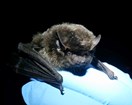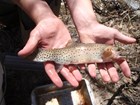The Midden is the Resource Management Newsletter of Great Basin National Park, published each summer and winter. Find out the latest going on at Great Basin National Park, Nevada in resource management and research. The Midden - Great Basin National Park: Vol. 16, No. 2, Winter 2016.
-
Great Basin National Park
Article 1: Saving Bonneville Cutthroat Trout after the Strawberry Fire
In August 2016, a wildfire burned the Strawberry Creek drainage, destroying much of the riparian corridor and degrading prime Bonneville cutthroat trout (Oncorhynchus clarki utah, BCT) habitat. Initial investigations concluded that a large portion of the BCT population was lost, most likely succumbing to increased water temperatures as the fire passed over the stream. However, survivors were found in less-intensely burned areas. Read more
-
Great Basin National Park
Article 2: New Wildlife Species Added to Cave List
Park staff have placed wildlife cameras at the entrances to several caves to see what animals use this habitat. The cameras take a photo when they sense movement. Each photo has a date, time, and temperature stamp. During the summer of 2013, 17 taxa were recorded. Since then, wildlife cameras have continued photographing cave entrances, and additional taxa have been added to the cave list. Read more
-
Great Basin National Park
Article 3: Northern Goshawk Occupancy and Breeding Surveys
Northern goshawks are large diurnal raptors that can be found year-round at Great Basin National Park. Although this bird of prey is a Nevada resident, it has been listed as a sensitive species by Great Basin National Park, the Bureau of Land Management, U.S. Forest Service, and the Nevada National Heritage Program. In order to better understand their ecology, habitat use, and nest and fledgling success, we conducted northern goshawk surveys in July and August. Read more
-
Great Basin National Park
Article 4: 2016 Nevada Bat Blitz
The Diversity Division of the Nevada Department of Wildlife (NDOW), along with other partners (including National Park Service (NPS), Bureau of Land Management (BLM), Friends of the High Rock-Black Rock, University of Nevada, Reno, and Humboldt State University), held the annual Nevada Bat Blitz in northwestern Washoe County, in and around the High Rock Wilderness area on August 8-12, 2016. Read more
-
Great Basin National Park
Article 5: Bat Research in Great Basin National Park: A Year in Review

Several threats to the populations of North American bats have been identified in the recent decade, mainly White Nose Syndrome, wind turbines, and habitat loss. Bats in the Great Basin region are insectivores, many of which can eat up to their own body weight in insects in a single night. This provides the valuable ecosystem service of suppressing agricultural pests, estimated to be billions of dollars a year in value. Read more
-
Great Basin National Park
Article 6: Precipitation Record at Great Basin National Park
Continuous precipitation data for Great Basin National Park, recorded at the Lehman Caves Visitor Center (LCVC), extend back to 1937. Read more
-
Great Basin National Park
Article 7: Bristlecone Cave Climate Studies

In August 2016, three dataloggers were downloaded in the difficult-to-access Bristlecone Cave, located above 10,000 feet. These dataloggers had been programmed in 2011 to record temperatures every two hours and were placed in various locations: the top, about 10 feet below the entrance; Pendulum Pit, about 90 feet down; and the Side Passage, about 80 feet down. Read more




